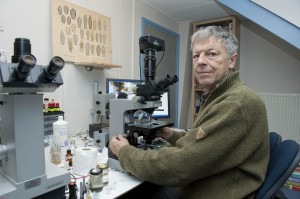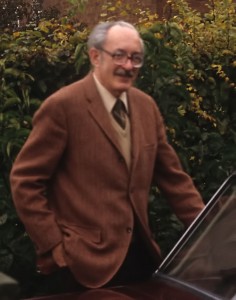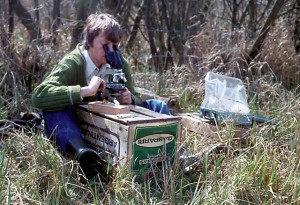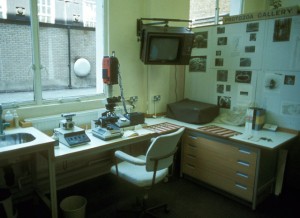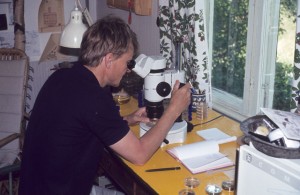Ferry Siemensma is an independent researcher in the Netherlands, and a leading expert on several groups of amoeboid and heliozoan organisms. For the past two years he’s been building a website devoted to his favourite creatures: Microworld: world of Amoeboid Organisms. This was an ambitious project from the beginning, but over time it has gradually turned into something that hasn’t been seen since the comprehensive texts of Cash, Wailes and Hopkinson, or Eugène Penard: a wide-ranging illustrated guide, featuring good formal descriptions, keys for identification, and up-to-the minute taxonomy. Ferry kindly agreed to answer my questions, in the first of what I hope will be a regular series of “Meet the Protistologist” interviews.
Your enthusiasm for your research reminds me of Joseph Leidy’s recorded remark: “How can life be tiresome so long as there is still a new rhizopod undescribed?” He was not raised in natural science (his father was in the hat business), but even in childhood he was driven “to see how plants and animals are made.” What was your upbringing like?
I grew up in a rural community in the northern part of the Netherlands. My father was a carpenter and I was the oldest of nine children. We always played on our uncle’s farm around the corner, and there I got my first interest in nature. I became a voracious reader of popular books about science and biology and in one of them I read the word “amoeba”. For me it was such a magic word, I don’t know why. From then on I was determined to find such a creature once. I was 14 years old when I bought a cheap Japanese microscope for about $10, which was pretty expensive in 1962. I could recognize some moving protists with it, but no amoebae. Many years later, at the age of 22, I became a teacher in a primary school, where I worked with 11-12 year old children. I also took a study to become a biology teacher and during that study we were offered to buy a Lomo microscope. This Russian instrument was really great, and it had a wonderful 70X water-immersion. From the day I got that scope, my life changed completely!
So, you were a schoolteacher, like Alfred Kahl! What changed in your life after you acquired the Lomo?
From then on, for more than 12 years, I looked through the microscope nearly every evening. My three daughters were very young at that time and went to bed very early, which was a great advantage ;-). Very soon I got in contact with Rob Wellner, who was looking for a microscope friend. We worked together for two days a week for many years. He taught me a lot, but his main interest was algae and I shifted to amoebae and heliozoa. In that time I got in contact with Dr. De Groot, a well known Dutch amoeba specialist. We smoked a lot of cigars together and had nice talks about our shared interest.
When he died in 1981, he left me his scientific literature, with the books of Leidy, Penard and Cash, which was a great luck for me, because in that time it was very difficult to get any papers. There was no internet, which is very hard to imagine now. In the meantime I also got in contact with Fred Page in Cambridge. He is such a pleasant man and we wrote each other a lot of letters. I went twice to Cambridge to see him.
He gave me the address of a Danish microscopist, Niels Willumsen. I phoned him, he invited me and that was the beginning of a very long friendship. One day I got a letter from Rudi Roijackers, who worked at the University of Wageningen. He offered me the use of an electron microscope and that was an excellent chance to get new information about heliozoa. I hunted for heliozoa, isolated them, made dried preparations and once a week we looked at the results in the SEM. We discovered new species and published some papers. I also published two booklets in Dutch about heliozoa and naked amoebae. Than I was invited to write the heliozoan part of the German Protozoenfauna. Fred Page wrote the other part on naked amoebae. The book was published in 1991.
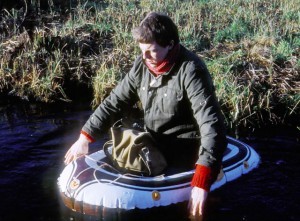
Ferry on a sampling excursion, 1981. (Photo by Niels Willumsen, who later capsized in the same boat)
Looking at your publications during this period, you were very active, especially with heliozoans. It must have been a thrill to be among the first to see EM images of the very intricate scales in certain groups! Were there certain organisms that you found particularly fascinating?
I was intrigued by the scales of Rabdiophrys species, though they aren’t true heliozoans. Those scales had been studied ten years before by Thomsen and I found them very beautiful subjects to make drawings of. One problem was to interpret the information on the SEM photomicrographs and to form a 3-dimensional image of those scales, which was really a challenge, and very fascinating, which was also true for the base of many kind of spiculae of the true heliozoans.
If you don’t mind my asking, was it a struggle to find funding and free time for this research? Did you continue to teach?
No, there was no funding, because the work at the university of Wageningen was part of the research of Rudi Roijackers. His interest was Mallamonas and he wanted to find out which scales belongs to heliozoans and which to Mallamonas species. He helped me with the SEM, I helped him with the identification.
Concerning my free time, I did all my research in the evening, the weekends and in my ample holidays. The latter was the big advantage of being a teacher! Schools were closed on Wednesday afternoon, so once a month on Wednesday I jumped into my car and drove to the SEM, one hour driving from my house! Teachers didn’t have a great salary, and they still don’t, so in that time I cleaned every cover glass in order to reuse it 😉
I still clean coverslips, unless they have immersion oil on them!:) In the decade between Nackte Rhizopoda und Heliozoea and the ISOP Illustrated Guide, you seem to have published less frequently. Were you pursuing other interests, or simply working quietly on your own?
There came a moment that I didn’t find any more new heliozoans. Preparing them for the SEM was a lot of work. First I had to find one, then to decide if it could be a new species, then came the process of removing the cover glass, which was the most complicated part, isolating the specimen, drying it, marking it and finally cutting the slide for the SEM.
After some months without any positive hit, my interest faded. It was at that time, as my girls grew older and needed my attention, that I got very interested in computers and I had a chance to start a science magazine for children – all in my free time. For many years a layer of dust grew slowly on my microscope…
Did you make room for amoebae in your magazine? It always seems to me that popular science publications have too many telescopes and not enough microscopes!
No, it was intended for 10-14 year old children, and they don’t usually own a microscope.
When did you decide to blow the dust off your microscope, and what brought you back?
Some years ago I got a letter from a woman working at a waterlaboratorium here in the Netherlands. They control the drinkwater quality and had problems with amoebae transporting Legionella bacteria through their filters. They needed my help for identification and had found my name with Google. And there I went to the lab and worked a whole day with a microscope…after so many years. I enjoyed it so much, it was a wake-up call. From that day on, I decided to start again. My first look through my Russian microscope taught me that it was unusable anymore: completely worn out. I bought a secondhand Zeiss standard and later an Orthoplan with DIC and phase contrast and other stuff on eBay. And so I came back home again!
In your website, your experience as an educator and your expertise with amoeboids have come together. How did this project begin?
I started this project about two years ago with the intention to make a survey of all the Dutch amoebae, and as replacement for the book of Hoogenraad & De Groot (1940). Here I could combine my interest in computers, nature, photography and drawing. But soon there came questions from people in the forums who asked for identifications of their findings and I started to publish their photographs also on my site. And then I realized it would be nice to cover the whole world. But it’s a huge project, in fact too much for one person. Every day there are new discoveries to document, new photomicrographs to edit and to archive and new email to answer. But I’m building my site stone by stone… uh.. shell by shell, without hurry and without any pressure. I love it!
While developing your website, you are continuing to do original research. Can you talk about that work?
I’m very interested in the variation within populations. Probably you know how difficult it is to distinguish between certain Centropyxis species, and the same is true for Difflugia, Euglypha, Cyphoderia and many other taxa. I’m measuring populations from different localities and will see what comes out. At the moment I have an Austrian sample with a population of Pseudonebela africana, which is new for Europe. It has been described from Africa and Brazil as having dimensions between 78 and 100 µm, but I find shells which are 85-185 µm long. That’s really interesting, and shows how little we know of populations in the wild. As these specimens are living, I also have the opportunity to observe their feeding behavior which is the same of that of Difflugia rubescens, and these specimens also have the same red color. They must be related. I’m fascinated by the behavior of amoeboids. I’m using a nice and simple, but very successful method for observations, the so-called “wet chambers” where I keep my wet mounts. It’s always a surprise, what comes up in such mounts after several days. Not seldom some species multiply rapidly and attach to the cover glass. which is excellent for observations. Mmm… I can go on for many hours…
It would be a pleasure to spend those hours with you, and I hope I will have the chance, one day. Thank you so much for taking the time to do this.
